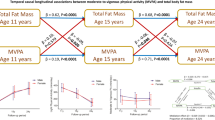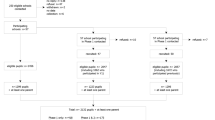Abstract
Background/Objectives:
To examine the association between parental body mass index (BMI) and their offspring’s body composition, physical fitness and lifestyle factors (that is, sedentary time, physical activity and diet).
Subjects/Methods:
A total of 307 preschoolers (4.5±0.1 years) and their parents (fathers: 38.1±5.1 years and mothers: 35.6±4.2 years) participated in this study. Parental BMI was calculated using self-reported weight and height. Preschoolers body composition was assessed using: BMI, fat mass percentage, fat mass index, fat-free mass index (measured via air-displacement plethysmography) and waist circumference. Physical fitness was assessed by the PREFIT fitness battery. Lifestyle factors were assessed using the ActiGraph wGT3x-BT (sedentary time and physical activity), and the mobile-phone based tool for energy balance in children (diet).
Results:
Parental BMI were positively associated with their offspring’s BMI (paternal BMI: standardised beta, β=0.233, P<0.001; maternal BMI: β=0.186, P=0.001), fat mass index (paternal BMI: β=0.130, P=0.026; maternal BMI: β=0.163, P=0.005), fat-free mass index (paternal BMI: β=0.214, P<0.001; maternal BMI: β=0.119, P=0.036) and waist circumference (paternal BMI: β=0.178, P=0.001; maternal BMI: β=0.179, P=0.001). A negative association was found between maternal BMI and their offspring’s standing long jump test (β=−0.132, P=0.022). Paternal BMI was associated with their offspring’s sedentary time (β=0.100, P=0.026), whereas parental BMI was not associated with neither physical activity nor diet (all P⩾0.104).
Conclusions:
Parental BMI was positively associated with their offspring’s BMI, fat as well as fat-free mass index and waist circumference. Moreover, a higher paternal and maternal BMI were related to higher levels of sedentary time and a lower performance in the standing long jump test of their offspring, respectively.
This is a preview of subscription content, access via your institution
Access options
Subscribe to this journal
Receive 12 print issues and online access
$259.00 per year
only $21.58 per issue
Buy this article
- Purchase on Springer Link
- Instant access to full article PDF
Prices may be subject to local taxes which are calculated during checkout

Similar content being viewed by others
References
Brisbois TD, Farmer AP, McCargar LJ . Early markers of adult obesity: a review. Obes Rev 2012; 13: 347–367.
Parsons TJ, Power C, Logan S, Summerbell CD . Childhood predictors of adult obesity: a systematic review. Int J Obes Relat Metab Disord 1999; 23 (Suppl 8), S1–107.
Fantin R, Delpierre C, Dimeglio C, Lamy S, Barboza Solis C, Charles MA et al. Disentangling the respective roles of the early environment and parental BMI on BMI change across childhood: a counterfactual analysis using the Millennium Cohort Study. Prev Med 2016; 89: 146–153.
Ohlund I, Hernell O, Hornell A, Stenlund H, Lind T . BMI at 4 years of age is associated with previous and current protein intake and with paternal BMI. Eur J Clin Nutr 2009; 64: 138–145.
Sijtsma A, Sauer PJ, Corpeleijn E . Parental correlations of physical activity and body mass index in young children- the GECKO Drenthe cohort. Int J Behav Nutr Phys Act 2015; 12: 132.
Devakumar D, Grijalva-Eternod C, Cortina-Borja M, Williams J, Fewtrell M, Wells J . Disentangling the associations between parental BMI and offspring body composition using the four-component model. Am J Hum Biol 2016; 28: 524–533.
Forsum E, Flinke Carlsson E, Henriksson H, Henriksson P, Lof M . Total body fat content versus BMI in 4-year-old healthy Swedish children. J Obes 2013; 2013: 206715.
Labayen I, Ruiz JR, Ortega FB, Loit H, Harro J, Veidebaum T et al. Intergenerational cardiovascular disease risk factors involve both maternal and paternal BMI. Diabetes Care 2010; 33: 894–900.
Ortlieb S, Schneider G, Koletzko S, Berdel D, von Berg A, Bauer CP et al. Physical activity and its correlates in children: a cross-sectional study (the GINIplus and LISAplus studies). BMC Public Health 2013; 13: 349.
Pei Z, Flexeder C, Fuertes E, Standl M, Berdel D, von Berg A et al. Mother/'s body mass index and food intake in school-aged children: results of the GINIplus and the LISAplus studies. Eur J Clin Nutr 2014; 68: 898–906.
Delisle C, Sandin S, Forsum E, Henriksson H, Trolle-Lagerros Y, Larsson C et al. A web- and mobile phone-based intervention to prevent obesity in 4-year-olds (MINISTOP): a population-based randomized controlled trial. BMC Public Health 2015; 15: 95.
Delisle Nyström C, Forsum E, Henriksson H, Trolle-Lagerros Y, Larsson C, Maddison R et al. A mobile phone based method to assess energy and food intake in young children: a validation study against the doubly labelled water method and 24 h dietary recalls. Nutrients 2016; 8: 50.
Henriksson P, Cadenas-Sanchez C, Leppänen M, Delisle Nyström C, Ortega FB, Pomeroy J et al. Associations of fat mass and fat-free mass with physical fitness in 4-year-old children: results from the MINISTOP trial. Nutrients 2016; 8: 473.
Leppanen MH, Nystrom CD, Henriksson P, Pomeroy J, Ruiz JR, Ortega FB et al. Physical activity intensity, sedentary behavior, body composition and physical fitness in 4-year-old children: results from the Ministop trial. Int J Obes (Lond) 2016; 40: 1126–1133.
Cadenas-Sanchez C, Nyström C, Sanchez-Delgado G, Martinez-Tellez B, Mora-Gonzalez J, Risinger AS et al. Prevalence of overweight/obesity and fitness level in preschool children from the north compared with the south of Europe: an exploration with two countries. Pediatr Obes 2016; 11: 403–410.
Fields DA, Allison DB . Air-displacement plethysmography pediatric option in 2–6 years old using the 4-compartment model as a criterion method. Obesity 2012; 20: 1732–1737.
Cadenas-Sanchez C, Martinez-Tellez B, Sanchez-Delgado G, Mora-Gonzalez J, Castro-Pinero J, Löf M et al. Assessing physical fitness in preschool children: feasibility, reliability and practical recommendations for the PREFIT battery. J Sci Med Sport 2016; 19: 910–915.
World Health Organization. Obesity: preventing and managing the global epidemic. World Health Organ Tech Rep Ser 894. World Health Organization: Geneva, 2000.
Linabery AM, Nahhas RW, Johnson W, Choh AC, Towne B, Odegaard AO et al. Stronger influence of maternal than paternal obesity on infant and early childhood BMI: the Fels Longitudinal Study. Pediatr Obes 2013; 8: 159–169.
Steffen LM, Sinaiko AR, Zhou X, Moran A, Jacobs Jr DR, Korenfeld Y et al. Relation of adiposity, television and screen time in offspring to their parents. BMC Pediatr 2013; 13: 133.
Lawlor DA, Timpson NJ, Harbord RM, Leary S, Ness A, McCarthy MI et al. Exploring the developmental overnutrition hypothesis using parental–offspring associations and FTO as an instrumental variable. PLOS Med 2008; 5: e33.
Bigaard J, Frederiksen K, Tjønneland A, Thomsen BL, Overvad K, Heitmann BL et al. Body fat and fat-free mass and all-cause mortality. Obes Res 2004; 12: 1042–1049.
Ortega FB, Ruiz JR, Castillo MJ, Sjostrom M . Physical fitness in childhood and adolescence: a powerful marker of health. Int J Obes (Lond) 2008; 32: 1–11.
Celis-Morales C, Livingstone KM, Woolhead C, Forster H, O'Donovan CB, Macready AL et al. How reliable is internet-based self-reported identity, socio-demographic and obesity measures in European adults? Genes Nutr 2015; 10: 476.
Lioret S, Touvier M, Balin M, Huybrechts I, Dubuisson C, Dufour A et al. Characteristics of energy under-reporting in children and adolescents. Br J Nutr 2011; 105: 1671–1680.
Cole TJ, Lobstein T . Extended international (IOTF) body mass index cut-offs for thinness, overweight and obesity. Pediatr Obes 2012; 7: 284–294.
Chandler JL, Brazendale K, Beets MW, Mealing BA . Classification of physical activity intensities using a wrist-worn accelerometer in 8-12-year-old children. Pediatr Obes 2016; 11: 120–127.
Acknowledgements
The research team would like to acknowledge the participating parents and their four-year-old children for their valuable contribution to this study. Marie Löf received grants from the Swedish Research Council for Health, Working Life and Welfare, as well as the Swedish Research Council to conduct this study. Cristina Cadenas-Sanchez’s work was supported by a grant from the Spanish Ministry of Economy and Competitiveness. (BES-2014-068829) MINISTOP is registered as a clinical trial (https://clinicaltrials.gov/: NCT02021786). Pontus Henriksson is supported by Henning and Johan Throne-Holst Foundation. Hanna Henriksson is supported by grants from the Swedish Society of Medicine and the County Council of Östergötland, Sweden. Jonatan R Ruiz and FB Ortega are supported by grant from the Spanish Ministry of Science and Innovation (RYC-2010-05957 and RYC-2011-09011, respectively). Additional funding was obtained from the University of Granada, Plan Propio de Investigación 2016, Excellence actions: Units of Excellence; Unit of Excellence on Exercise and Health (UCEES). In addition, funding was provided by the SAMID III network, RETICS, the PN I+D+I 2017-2021 (Spain), ISCIII- Sub-Directorate General for Research Assessment and Promotion, the European Regional Development Fund (ERDF) (RD16/0022) and the EXERNET Research Network on Exercise and Health in Special Populations (DEP2005-00046/ACTI). This study is part of a PhD Thesis conducted in the Biomedicine Doctoral Studies of the University of Granada, Spain.
Author information
Authors and Affiliations
Corresponding author
Ethics declarations
Competing interests
The authors declare no conflict of interest.
Rights and permissions
About this article
Cite this article
Cadenas-Sanchez, C., Henriksson, P., Henriksson, H. et al. Parental body mass index and its association with body composition, physical fitness and lifestyle factors in their 4-year-old children: results from the MINISTOP trial. Eur J Clin Nutr 71, 1200–1205 (2017). https://doi.org/10.1038/ejcn.2017.62
Received:
Revised:
Accepted:
Published:
Issue Date:
DOI: https://doi.org/10.1038/ejcn.2017.62
This article is cited by
-
Prepregnancy maternal BMI and trajectories of BMI-for-age in children up to four years of age: findings from the 2015 Pelotas (Brazil) birth cohort
International Journal of Obesity (2024)
-
Gestational weight gain and visceral adiposity in adult offspring: Is there a link with the fecal abundance of Acidaminococcus genus?
European Journal of Clinical Nutrition (2022)
-
Maternal overweight but not paternal overweight before pregnancy is associated with shorter newborn telomere length: evidence from Guangxi Zhuang birth cohort in China
BMC Pregnancy and Childbirth (2021)
-
Developmental Programming of Body Composition: Update on Evidence and Mechanisms
Current Diabetes Reports (2019)



